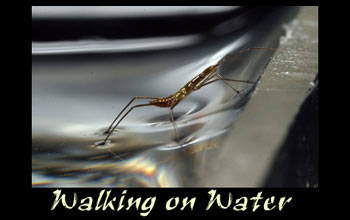|

Press Release 05-171
For These Bugs, Walking on Water Is Easy

Getting out of the pond is the problem
September 28, 2005
A "meniscus"—the crescent-shaped and barely visible slope literally at water's edge—can mean life or death to an insect the size of a speck of dust. Water bugs that tiny must summon the energy to "surf" themselves up the problematic interface between liquid and solid in ponds and other wet places to escape predators or reproduce.
Menisci are all around us, "but we don't notice them because they're so small, only a few millimeters in height," said mathematician David Hu of the Massachusetts Institute of Technology. "But if you're a creature that's much smaller than that, those slopes "are like frictionless mountains," said Hu. "Plus, it's slippery."
Now, Hu and coworker John Bush have done the math to explain how nearly weightless water walkers find the traction to ascend a wall of water several times their height. Such obstacles, which are almost invisible to humans, may surround a leaf floating in a stream or a stone on the riverbank.
An article on the work appears in the Sept. 29 issue of the journal Nature.
According to Bush, the study, which was funded by the National Science Foundation, may be "of interest to people working in nanotechnology, because they, too, are concerned with problems at very small scales."
Read the full release from MIT at www.web.mit.edu/newsoffice/
-NSF-

Media Contacts
Leslie Fink, NSF (703) 292-5395 lfink@nsf.gov
Elizabeth Thomson, MIT (617) 258-5402 thomson@mit.edu
Related Websites
Meniscus-Climbing Insects web site: http://www-math.mit.edu/~dhu/Climberweb/climberweb.html

The National Science Foundation (NSF) is an independent federal agency that supports fundamental research and education across all fields of science and engineering. In fiscal year (FY) 2009, its budget is $9.5 billion, which includes $3.0 billion provided through the American Recovery and Reinvestment Act. NSF funds reach all 50 states through grants to over 1,900 universities and institutions. Each year, NSF receives about 44,400 competitive requests for funding, and makes over 11,500 new funding awards. NSF also awards over $400 million in professional and service contracts yearly.
 Get News Updates by Email Get News Updates by Email
Useful NSF Web Sites:
NSF Home Page: http://www.nsf.gov
NSF News: http://www.nsf.gov/news/
For the News Media: http://www.nsf.gov/news/newsroom.jsp
Science and Engineering Statistics: http://www.nsf.gov/statistics/
Awards Searches: http://www.nsf.gov/awardsearch/
| 

